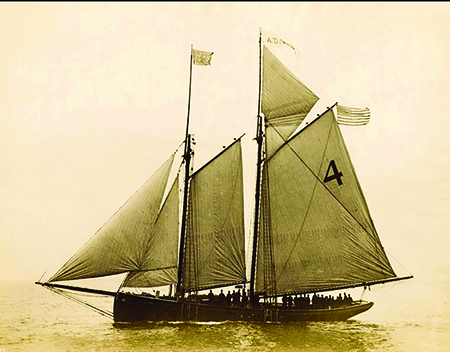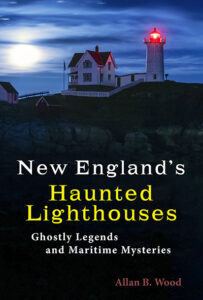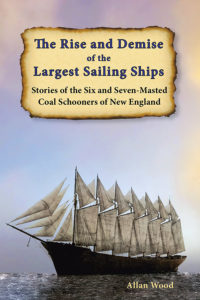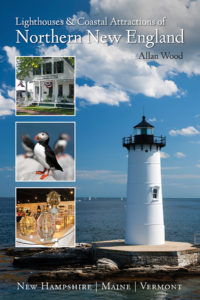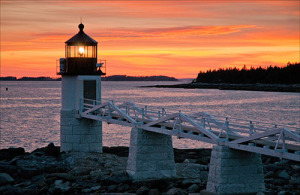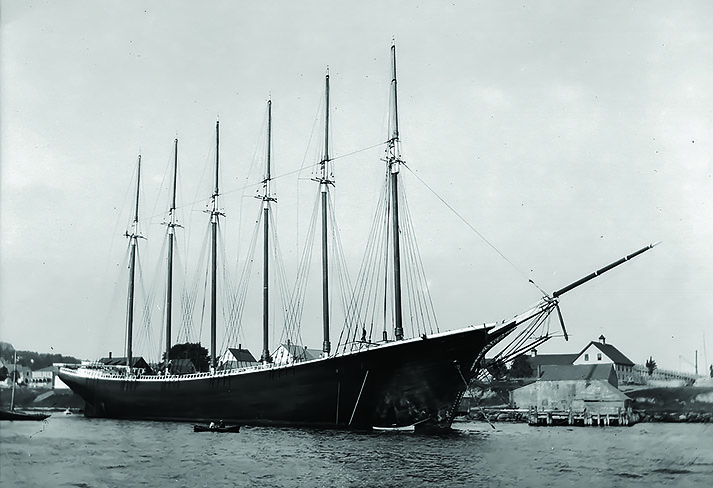
The first six-masted schooner sailing ship, the George W. Wells (1900). Image Camden Public Library.
Captain York, Commander of the Six-Masted Schooner, the George W. Wells, Narrowly Escapes From an Explosive Fire on His Boat in Boston Harbor
Since 1907, Captain York was commander of the first six-masted wooden schooner, the George W. Wells, after its previous captain was placed on another vessel. He had a cabin cruiser named Camille that he loved to tour around Boston Harbor. With the day off, on Thursday, November 16, 1911, he left early in the morning from the pier of the Massachusetts Coal Company at East Boston. It was great timing to go fishing with his brother R. M. York and a friend, J. E. Bryant, as the George W. Wells was unloading her cargo. His boat, like most, was equipped with a little flat-bottomed tender rowboat used to bring the captain and guests to and from the larger powerboat. They had started in Boston Harbor, passing Long Island Head Light and Deer Island Light, and had reached just beyond Boston Harbor Lighthouse.
Around 9:30 that morning, flames and smoke erupted inside the cabin, possibly from an engine fire. The fire was within a few feet of two 60-gallon gasoline tanks stored nearby. Fearing an imminent deadly explosion, they put the little tender boat over the side and jumped in. Time was crucial, and the craft was so small they almost swamped it as they tried to position themselves to escape. Water poured into the sides as they jumped in, and both men attempted to bail out the excess water while the captain started rowing away from the flaming vessel.
Only a few minutes later, the flames reached the gasoline tanks, and the boat exploded into an inferno over the water. They kept rowing and bailing out the water till they reached the safety of the pilot boat Adams, which just happened to be less than a half mile away from their location. The crew picked up the three grateful men and took them to nearby Fort Warren for safety. Meanwhile, a few miles away on the mainland in Hull, Patrolman Cole of the Point Allerton Life Saving Station noticed the fire and ran inside the station to notify Captain William Sparrow. The crew immediately launched their power lifeboat, although it was still a reasonable distance until they reached the pilot boat. Luckily, they noticed that the Adams team had picked up the survivors. They arrived at the vessel and ensured all were fine, then kept an eye on the burning cabin cruiser as the tide slowly took it out, allowing it to drift seaward. When it reached about a mile and a half from Boston Harbor Lighthouse, it burned to its waterline and sank beneath the waves where it didn’t threaten any nearby mariners.
Captain York and his two relieved companions were ferried from Fort Warren back to the Commercial Wharf in the harbor that afternoon using the quartermaster’s steamship, the General E. S. Jessup. The accident involved no injuries, and all were happy to be alive. The captain’s boat was valued at $3,000 (over $100,000 today) but insured for half that amount, which was standard practice.
Captain York remained commander of the George W. Wells until the great six-master sank in a hurricane storm off the Outer Banks of North Carolina in 1913. The local lifesavers all safely rescued him and his crew.
Books to Explore
New England’s Haunted Lighthouses:
Ghostly Legends and Maritime Mysteries
Discover the mysteries of the haunted lighthouses of New England! Uncover ghostly tales of lingering keepers, victims of misfortune or local shipwrecks, lost souls, ghost ships, and more. Many of these accounts begin with actual historical events that later lead to unexplained incidents.
Immerse yourself in the tales associated with these iconic beacons!
The Rise and Demise of the Largest Sailing Ships:
Stories of the Six and Seven-Masted Coal Schooners of New England.
In the early 1900s, New England shipbuilders constructed the world’s largest sailing ships amid social and political reforms. These giants were the ten original six-masted coal schooners and one colossal seven-masted vessel, built to carry massive quantities of coal and building supplies and measured longer than a football field! This self-published book, balanced with plenty of color and vintage images, showcases the historical accounts that followed these mighty ships, like the George W. Wells schooner commander, Captain York, and his experience with his own boat catching fire in Boston Harbor.
Available also from bookstores in paperback, hardcover, and as an eBook for all devices.

Book – Lighthouses and Coastal Attractions in Southern New England: Connecticut, Rhode Island, Massachusetts
Lighthouses and Coastal Attractions of Southern New England:
Connecticut, Rhode Island, and Massachusetts.
This 300-page book provides memorable human interest stories from each of the 92 lighthouses. You can explore plenty of indoor and outdoor coastal attractions, including whale-watching excursions, lighthouse tours, windjammer sailing tours, parks, museums, and even lighthouses where you can stay overnight. You’ll also find plenty of stories of hauntings around lighthouses.
Lighthouses and Coastal Attractions of Northern New England:
New Hampshire, Maine, and Vermont.
This 300-page book provides memorable human interest stories from each of the 76 lighthouses. It also describes and provides contact info for plenty of indoor and outdoor coastal attractions and tours. These include whale watching, lighthouse tours, unique parks, museums, and lighthouses where you can stay overnight. There are also stories of haunted lighthouses in these regions.
Copyright © Allan Wood Photography; do not reproduce without permission. All rights reserved.
Join, Learn, and Support The American Lighthouse Foundation
